Bios252 week 1 - Study guides, Class notes & Summaries
Looking for the best study guides, study notes and summaries about Bios252 week 1? On this page you'll find 19 study documents about Bios252 week 1.
All 19 results
Sort by
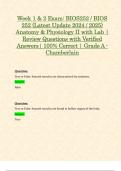
-
Week 1 & 2 Exam: BIOS252 / BIOS 252 (Latest Update 2024 / 2025) Anatomy & Physiology II with Lab | Review Questions with Verified Answers | 100% Correct | Grade A - Chamberlain
- Exam (elaborations) • 37 pages • 2024
- Available in package deal
-
- $7.99
- + learn more
Week 1 & 2 Exam: BIOS252 / BIOS 252 (Latest Update 2024 / 2025) Anatomy & Physiology II with Lab | Review Questions with Verified Answers | 100% Correct | Grade A - Chamberlain Question: True or False: Smooth muscles are characterized by striations. Answer: False Question: True or False: Smooth muscles are found in hollow organs of the body. Answer: True Question: True or False: Smooth muscles contain actin and myosin filaments. Answer: True Question: True or ...
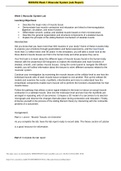
-
BIOS252 Week 1 Muscular System (Lab Report)
- Exam (elaborations) • 5 pages • 2022
-
- $19.49
- + learn more
Week 1 Muscular System Lab Learning Objectives: Describe the major roles of muscle tissue Demonstrate how muscle contraction and relaxation are linked to thermoregulation, digestion, circulation, and motor function. Differentiate smooth, cardiac and skeletal muscle based on their microstructure. Describe the general organization and structural components of a skeletal muscle. Explain the principle of the sliding filament mechanism of skeletal muscle Introduction Did ...

-
BIOS252 Week 1 Case Study; Muscles
- Other • 4 pages • 2022
- Available in package deal
-
- $22.49
- + learn more
1. Name the muscles severed during the amputation event. 2. If the patient were no longer to properly pronate his arm, which muscle do you think has been compromised? 3. In general, a patient with a severed limb has a smaller window of time for successful replantation when compared with finger replantation surgery. This is in part due to the difference in tissue composition of the two anatomical structures. What does this sayabout the metabolic demands for muscles, cartilage, and bone? Why do ...
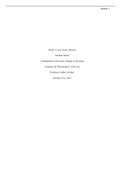
-
BIOS252 Week 1 Case Study; Muscle
- Other • 3 pages • 2022
- Available in package deal
-
- $22.49
- + learn more
1. Name the muscles severed during the amputation event. 2. If the patient were no longer to properly pronate his arm, which muscle do you think has been compromised? 3. In general, a patient with a severed limb has a smaller window of time for successful replantation when compared with finger replantation surgery. This is in part due to the difference in tissue composition of the two anatomical structures. What does this sayabout the metabolic demands for muscles, cartilage, and bone? Why do ...

-
BIOS 252 Week 1 Case Study Assignment: Muscles (GRADED A)
- Case • 3 pages • 2022
- Available in package deal
-
- $10.99
- + learn more
BIOS252-14403 Chamberlain University BIOS 252 Week 1 Case Study Assignment: Muscles 1. Name the muscles severed during the amputation event. The muscle name during amputation is the distal forearm. 2. If the patient were no longer to properly pronate his arm, which muscle do you think has been compromised? The pronator teres has been compromised. 3. In general, a patient with a severed limb has a smaller window of time for successful replantation when compared with finger replantation surgery. T...

-
BIOS252 Week 1 Discussion Question
- Other • 2 pages • 2022
- Available in package deal
-
- $15.49
- + learn more
Skeletal and cardiac muscle tissues contract via a process known as the sliding filament theory. In order to create these contractions, the muscle must be arranged in a specific pattern known as a sarcomere. Discuss the different components of the sarcomere, how they are arranged, and what changes (if any) happen to them when the muscle is contracted.
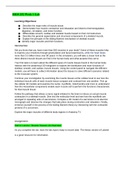
-
BIOS 252 Week 1 Muscular System - Lab
- Other • 5 pages • 2022
- Available in package deal
-
- $20.49
- 1x sold
- + learn more
Learning Objectives: ● Describe the major roles of muscle tissue ● Demonstrate how muscle contraction and relaxation are linked tothermoregulation, digestion, circulation, and motorfunction. ● Differentiate smooth, cardiac and skeletal muscle based on theirmicrostructure. ● Describe the general organization and structural components of a skeletalmuscle. ● Explain the principle of the sliding filament mechanism of skeletalmuscle ● Identify major muscles and their functions. In...
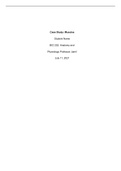
-
BIOS 252 Week 1 Case Study; Muscles
- Other • 4 pages • 2022
- Available in package deal
-
- $20.49
- + learn more
1. Name the muscles severed during the amputation event. 2. If the patient were no longer to properly pronate his arm, which muscle do you think has been compromised? 3. In general, a patient with a severed limb has a smaller window of time for successful replantation when compared with finger replantation surgery. This is in part due to the difference in tissue composition of the two anatomical structures. What does this sayabout the metabolic demands for muscles, cartilage, and bone? Why do ...
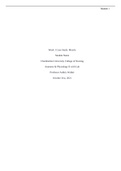
-
BIOS 252 Week 1 Case Study; Muscle
- Other • 3 pages • 2022
- Available in package deal
-
- $20.49
- + learn more
1. Name the muscles severed during the amputation event. 2. If the patient were no longer to properly pronate his arm, which muscle do you think has been compromised? 3. In general, a patient with a severed limb has a smaller window of time for successful replantation when compared with finger replantation surgery. This is in part due to the difference in tissue composition of the two anatomical structures. What does this sayabout the metabolic demands for muscles, cartilage, and bone? Why do ...

-
BIOS 252 Week 1 Discussion Question
- Other • 2 pages • 2022
- Available in package deal
-
- $12.49
- + learn more
Skeletal and cardiac muscle tissues contract via a process known as the sliding filament theory. In order to create these contractions, the muscle must be arranged in a specific pattern known as a sarcomere. Discuss the different components of the sarcomere, how they are arranged, and what changes (if any) happen to them when the muscle is contracted.

How did he do that? By selling his study resources on Stuvia. Try it yourself! Discover all about earning on Stuvia


